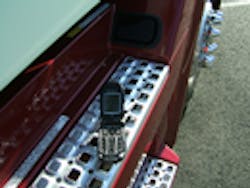7 steps to making mobile devices work in your fleet
My co-worker Wendy Leavitt has written extensively on the subject recently. Wendy smartly detailed some of the issues in a feature story for Fleet Owner’s December issue called Smart devices and fleet desires.
According to her research, a Gartner survey found that “90% of enterprises have already deployed mobile devices, with smartphones being most widely deployed.”
Among the benefits she found were that smart devices give fleets almost instant access to communications and computing technology at a relatively low cost. In the case of bring your own device (BYOD) policies, employees themselves bear some or all of the device cost. The lower cost of entry can also make it easier for fleets to keep up with rapid changes.
Experts also believe the proliferation of consumer devices have changed fleet strategies.
“Consumer mobile devices are putting powerful computers directly into a driver’s hands,” noted XRS in a recent white paper. “These mobile devices are powered through an invisible cloud structure, constantly transmitting large amounts of data in real time. Drivers, dispatchers, safety managers and trucking fleet owners are connected while being spread across the country. And it’s affordable for everyone, not just the lonely few who could afford yesterday’s technology.”
With that said, on the surface, it would appear that a bring your own device policy is the way to go for many fleets. But, implementing such a policy has its own pitfalls to watch out for.
Apptricity is a provider of mobile enterprise software solutions. Its founder and CEO, Timothy D. Garcia recently detailed some of the challenges to a BYOD policy and how you can overcome them.
- Program devices and develop apps. “Since most employees will be using either iOS, Android, Windows or even Blackberry devices to connect to the company network, money needs to be invested to program each of those mobile platforms into the network,” said Garcia. “This will require developing or purchasing apps that allow employees to connect to the company’s network. Additional funds will be necessary to keep these apps up-to-date.”
- Train employees. “Your employees will need to be taught how to use the apps, as well as all the necessary security procedures,” said Garcia. “Intuitive usability should be a key factor in selecting any software.”
- Data lag. “Since BYOD connections typically are made via public wireless communication networks, there’s likely going to be some lag time,” says Garcia. “For supply chain data transmission functions, a 30-second to 3-minute delay can introduce significant and costly inefficiencies. It’s important to ensure that the apps you choose grant real-time command visibility.”
- Cell coverage issues. “Warehouses are often located in industrial parks or areas where cell transmission capacity is relatively low,” said Garcia. “Big metal warehouses are notorious for cell transmission problems. Spotty coverage can cause trouble for companies that rely heavily on seamless communication. Make sure that the platform can accommodate these “breakages” and not lose valuable data.”
- Device ruggedness. “Supply chain environments are tough places for handheld devices,” says Garcia. “There’s dirt, dust, water and concrete floors. Employers have to decide if the company should be able to dictate what devices employees can use.”
- Data security. “Companies must ask themselves several questions regarding cyber security when considering the potential risk to data security,” says Garcia. “Where do employees store corporate or customer data? What if a smartphone is lost or stolen? Are the data transmissions secure? How does the company get its data back and secured when an employee leaves the company? How does your company prevent accidental sharing of corporate or private data? Are the solutions compliant with security protocols?”
- Device support. “Inevitably, employees’ devices will hiccup every once in a while and your employees will make mistakes while using their own devices,” said Garcia. “Companies must determine ahead of time who is responsible for certain costs. Should your company hire and train experts in all the mobile platforms – or outsource that work? If company-provided troubleshooting leads to a device being rendered permanently unusable, who pays to replace it? Does the software have a user experience that is easy to use and reduces potential for errors?”

